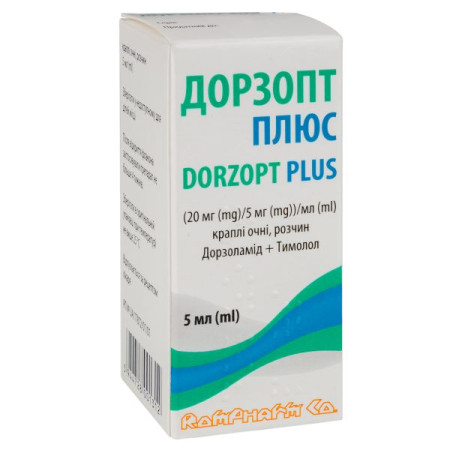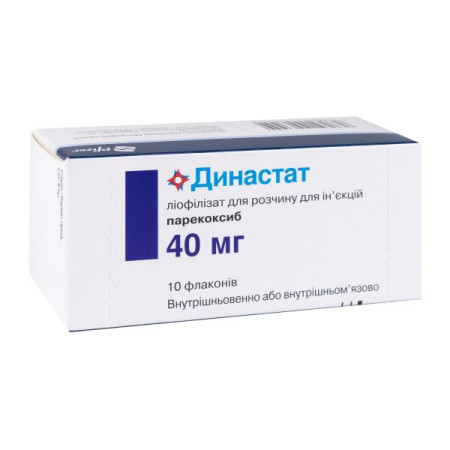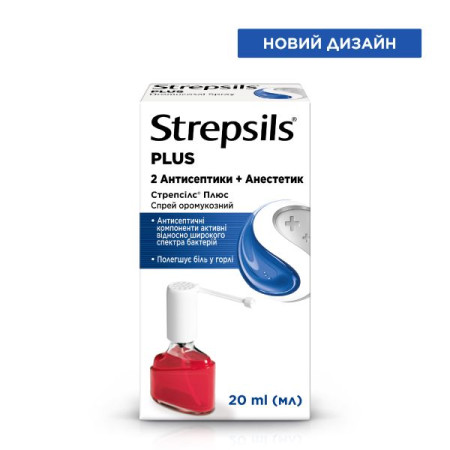Timolol-Darnitsa eye drops solution 5 mg/ml bottle 5 ml

Instructions for use Timolol-Darnitsa eye drops solution 5 mg/ml bottle 5 ml
Composition
active ingredient: timolol;
1 ml of the drug contains timolol maleate equivalent to timolol 2.5 mg and 5 mg;
Excipients: benzalkonium chloride, sodium chloride, sodium dihydrogen phosphate dihydrate, sodium hydrogen phosphate dodecahydrate, disodium edetate, water for injections.
Dosage form
Eye drops, solution.
Main physicochemical properties: clear colorless liquid.
Pharmacotherapeutic group
Antiglaucoma drugs and miotics. β-adrenergic blockers.
ATX code S01E D01.
Pharmacological properties
Pharmacodynamics.
Timolol is a β1- and β2-adrenergic receptor blocker. When instilled into the eye, it reduces intraocular pressure, mainly by reducing the production of intraocular fluid. The effect is associated with inhibition of the adenylate cyclase system of the ciliary tissue, which carries out the active transport of sodium from the blood into the intraocular fluid, which leads to a decrease in the intensity of the moisture formation process. Does not affect accommodation, refraction and pupil size. When instilled into the eye, it reduces both elevated and normal intraocular pressure. The pressure is reduced without a significant effect on accommodation, which is an advantage compared to antiglaucoma drugs with miotic action.
Pharmacokinetics.
The effect of the drug appears 20 minutes after instillation. The maximum effect occurs after 1-2 hours and lasts from 8 to 24 hours. After topical application of the recommended doses, the drug is practically not detected in the blood plasma (less than 2 ng/ml).
Timolol maleate and its metabolites are excreted primarily by the kidneys.
Indication
The drug is used for ocular hypertension, chronic open-angle glaucoma, and some cases of secondary glaucoma.
Contraindication
Hypersensitivity to the components of the drug.
Decompensated or acute heart failure, some types of cardiac arrhythmias
(II or III degree AV block, sinus bradycardia), cardiogenic shock.
Bronchial asthma, chronic obstructive pulmonary disease.
Interaction with other medicinal products and other types of interactions
When used simultaneously with Timolol-Darnitsa:
Eye drops containing pilocarpine and adrenaline enhance the reduction of intraocular pressure.
Cholinomimetics (pilocarpine), adrenomimetics (epinephrine), carbonic anhydrase inhibitors, taufon: can be combined with Timolol-Darnitsa to achieve a more pronounced and long-lasting reduction in intraocular pressure.
Eye drops containing β-blockers should not be prescribed together with Timolol-Darnitsa.
Concomitant use of epinephrine with timolol may cause mydriasis.
Calcium antagonists, reserpine and β-blockers may potentiate the decrease in blood pressure and slowing of heart rate.
Cardiac glycosides cause prolongation of atrioventricular conduction time, bradycardia, and AV block.
Insulin and oral antidiabetic agents contribute to hypoglycemia.
The effect of muscle relaxants is enhanced, so the drug should be discontinued 48 hours before scheduled surgery with general anesthesia. Neuromuscular blockade caused by tubocurarine may be enhanced by β-blockers.
The effect of β2-sympathomimetics may be reduced, there is a risk of bronchospasm.
Quinidine enhances the β-blocking effect of the drug by reducing the activity of P450 enzymes, CYP2D6, responsible for the metabolism of timolol.
Clonides. In case of simultaneous use, clonidine should be discontinued gradually and only a few days after discontinuation of Timolol-Darnitsa. Re-administration of the drug is possible only a few days after discontinuation of clonidine.
Nicardipine, diltiazem. When oral nicardipine and diltiazem were administered simultaneously with Timolol-Darnitsa instillations, no enhancement of the effects of the latter was observed.
Cimetidine may cause an increase in the effect of Timolol-Darnitsa.
Application features
Timolol does not cause or affect mydriasis when used as monotherapy. Regular measurement of intraocular pressure and corneal examination should be performed.
When transferring patients to timolol treatment, refractive correction may be required after the effects of previously used miotic agents have worn off.
In the case of surgery using general anesthesia, the drug must be discontinued at least 48 hours in advance.
Caution should be exercised when discontinuing the drug in patients with suspected thyroid disorders (e.g. hyperthyroidism, thyrotoxicosis) to reduce the risk of worsening of such disorders. Blood glucose levels should be monitored (especially in diabetes mellitus). Tear production and corneal condition should be monitored every 6 months.
Topically applied β-blockers may be systemically absorbed. Therefore, the same adverse reactions may occur with topical administration of the drug as with systemic β-blockers. Serious respiratory and cardiovascular reactions, including fatalities due to bronchospasm in patients with asthma and, in isolated cases, cardiac failure, have been reported following the use of timolol maleate.
Because of the possible effects of β-blockers on blood pressure and pulse, these drugs should be used with caution in patients with cerebral insufficiency. If signs or symptoms of cerebral insufficiency develop after initiation of therapy with timolol, alternative therapy should be considered.
There are reports that β-blockers cause muscle weakness. This is associated with certain symptoms of myasthenia (e.g. diplopia, ptosis and general weakness); timolol causes muscle weakness in some patients with myasthenia gravis or symptoms of myasthenia.
The main problem in the treatment of patients with angle-closure glaucoma is the need to open the angle. This requires constriction of the pupil with the help of miotics. Timolol has practically no effect on the pupil. If timolol is used to reduce elevated intraocular pressure in angle-closure glaucoma, it should be prescribed together with a miotic. As with other antiglaucoma drugs, some patients have experienced a decrease in sensitivity to the drug after long-term therapy. However, no significant difference in mean intraocular pressure after initial stabilization was noted.
Beta-blockers should be gradually discontinued before general anesthesia because they reduce the heart's ability to respond to beta-adrenergic receptor stimulation.
Timolol should not be used while wearing contact lenses because the preservative benzalkonium chloride may be absorbed by soft contact lenses, discoloring them or causing eye irritation. Patients should be advised to remove contact lenses before instillation and wait 15 minutes before reinserting them.
If other eye medications are additionally used, it is necessary to take a break of 15 minutes between their instillation.
Risk of anaphylactic reactions: Patients with atopy or a history of severe pathological reactions to multiple allergens may react more severely to repeated accidental, diagnostic or therapeutic doses of these allergens if they have been treated with β-blockers. Such patients may not respond to the usual dose of adrenaline given in the event of anaphylactic reactions.
Cases of choroid detachment have been reported following glaucoma surgery and with the use of drugs that reduce the secretion of intraocular fluid. Such cases have been described in connection with the use of timolol and acetazolamide.
When using the drug, a positive result may be detected during doping control.
It should be noted that during stabilization of intraocular pressure, the initial decrease may be up to 50%, after which the effectiveness of the drug may decrease (tachyphylaxis). In the period from the 3rd to the 12th month, the decrease in pressure stabilizes. Therefore, it is important to regularly monitor the pressure during the first 5 days after the appointment of timolol eye drops.
Oral β-blockers may cause a decrease in intraocular pressure. In such cases, consideration should be given to the use of topical timolol eye drops. If systemic β-blockers have already been used, the additional effect of topical agents is usually less. Patients who are receiving additional oral β-blockers or for whom limited β-blocker use is indicated should be monitored regularly.
In patients with heavily pigmented irises, the pressure reduction may be delayed and to a lesser extent.
After stopping treatment, the effect of the drug may last for several days. If timolol treatment is stopped after long-term use, its effect on lowering intraocular pressure may last for 2-4 weeks.
When instilled into only one eye, β-blockers may have an effect on lowering intraocular pressure in the untreated eye as well.
Use during pregnancy or breastfeeding
Due to the lack of sufficient experience with the use of Timolol-Darnitsa during pregnancy or breastfeeding, the drug can be prescribed only if the expected therapeutic effect for the mother significantly outweighs the potential risk to the fetus/child.
Ability to influence reaction speed when driving vehicles or other mechanisms
The drug reduces visual acuity and affects reaction speed, so you should refrain from driving or working with other mechanisms during the treatment period.
Method of administration and doses
The bottle has a special configuration, thanks to which, when pressed on the bottom, the solution is dosed according to the principle of “one press – one drop”. The hardness of the bottle walls significantly reduces the possibility of the drug being released in a jet – the most common cause of eye drop overdose.
Timolol-Darnitsa should be instilled into the conjunctival sac of the affected eye by gently pressing the bottom of the bottle. Immediately after applying the drug, close the eyes and lightly press your finger on the inner corner of the eye (near the nose) for 1-2 minutes to prevent the solution from entering the tear ducts and reduce the possible systemic side effects of the drug.
At the beginning of therapy, 1 drop of 0.25% solution should be prescribed 2 times a day, with insufficient effectiveness - 1 drop of 0.5% solution 2 times a day. After normalization of intraocular pressure, the maintenance dose is 1 drop of 0.25% solution 1 time a day.
The duration of the treatment course is prescribed by the doctor individually.
If intraocular pressure is not adequately controlled, concomitant therapy with miotics, epinephrine, or systemic carbonic anhydrase inhibitors may be initiated.
Attention! If you wear contact lenses, you must remove them before using Timolol-Darnitsa. They can be put back on no earlier than 15 minutes later.
Children.
The efficacy and safety of the drug in children have not been established.
Overdose
The special configuration of the bottle makes accidental overdose of the drug unlikely. Overdose is possible if the single doses and frequency of use specified in the instructions are not observed.
Symptoms: dizziness, headache, arrhythmia, decreased blood pressure, development of heart failure, cardiogenic shock, bradycardia, bronchospasm, nausea, vomiting, confusion and convulsions; with accidental use of the drug internally (depending on the amount) - cardiac arrhythmia, shortness of breath, cyanosis of the nails, dizziness, weakness, nausea, vomiting, diarrhea.
Treatment: immediate eye washing with water or saline. In case of severe symptoms of overdose, antidotes should be used: atropine 0.5-2 mg intravenously; glucagon initially 1-10 mg intravenously, then 2-2.5 mg/hour as an infusion.
In case of accidental internal use of the drug, symptomatic therapy is indicated.
Adverse reactions
Local reactions: ocular discomfort, mild to moderate pain, burning and itching in the eyes, dryness, redness, hypotension, decreased corneal sensitivity, moderate keratopathy, superficial punctate keratitis, decreased image clarity, foreign body sensation, increased photosensitivity of the eye, corneal erosion, conjunctivitis, allergic conjunctivitis and blepharoconjunctivitis, objective and subjective symptoms of eye irritation, blepharitis, lacrimation, photophobia, epithelial edema and corneal hyperemia, conjunctival metaplasia, conjunctival hyperemia, disc hemorrhages, blurred vision, ocular pemphigoid, choroid detachment, eyelid contact dermatitis, retinal hemorrhage, keratitis, blepharoptosis, visual impairment (including refractive), diplopia, ptosis.
On the part of the immune system, skin and subcutaneous tissue: hypersensitivity, anaphylactic shock, urticaria, eczema, generalized and localized rashes, hypopigmentation, alopecia, deterioration of nail condition, stomatitis, psoriasis, lichen planus, allergic contact dermatitis, erythroderma, Lyell's syndrome.
Cardiovascular system: heart failure, bradycardia, significant decrease in pulse rate, arrhythmia, arterial hypotension, congestive heart failure, myocardial infarction, angina pectoris, arterial hypertension, cardiac dysfunction, cerebral infarction (transient cerebral circulatory disorders), syncope, palpitations, chest pain (including pain in the heart area), asystole, atrioventricular or sinoarterial block, bradyarrhythmia, collapse, cardiac arrest, stroke, cerebral vascular ischemia.
On the part of the respiratory system, chest organs and mediastinum: shortness of breath, asthmatic attacks, bronchospasm (especially in patients with pre-existing lung diseases), respiratory failure/arrest, respiratory distress syndrome (respiratory failure), decreased vital capacity, severe cough, increased bronchospasm, cyanosis, interstitial pneumopathy, dyspnea, nasal congestion.
From the nervous system: headache, dizziness, weakness, sensory disturbances, feelings of fear, hallucinations, neuromuscular disorders, asthenia, depression (including melancholic), fatigue, decreased libido, psychosis, drowsiness, malaise, mental disorders, terrible dreams, cerebral circulatory insufficiency (including cerebrovascular disorders, a sharp decrease in blood pressure), apathy, increased objective and subjective symptoms of myasthenia gravis, paresthesia.
Gastrointestinal: nausea, diarrhea, abdominal pain, dyspepsia.
On the part of the endocrine system: significant decrease in high-density lipoproteins (HDL) or cholesterol/HDL ratio, masking of symptoms of hypoglycemia in patients with insulin-dependent diabetes mellitus, weight gain, severe hyperglycemia.
General disorders and administration site conditions: fatigue.
Cardiovascular system: arterial hypertension, pulmonary edema, angina pectoris.
Gastrointestinal: dyspepsia, anorexia, dry mouth.
Psychiatric disorders: behavioral disorders, including confusion, hallucinations, anxiety, disorientation, agitation, drowsiness, and other mental disorders.
On the part of the organs of vision: cystoid macular edema of the cornea.
Renal and urinary disorders: retroperitoneal fibrosis, impotence.
Adverse reactions recorded in clinical practice with oral use of timolol maleate that may occur with ophthalmic use of timolol maleate.
General disorders and administration site conditions: pain in extremities, decreased exercise capacity, weight loss.
Cardiovascular system: edema, worsening of arterial insufficiency, Raynaud's disease, vasodilation.
Gastrointestinal: pain in the stomach or intestines, hepatomegaly, vomiting.
Blood and lymphatic system disorders: simple purpura.
From the endocrine system: hyperglycemia, hypoglycemia.
Skin and subcutaneous tissue disorders: itching, skin irritation, increased skin pigmentation, increased sweating, feeling of coldness in the extremities.
Musculoskeletal and connective tissue disorders: arthralgia, lameness.
From the nervous system: dizziness, weakness, decreased sexual desire, nightmares, insomnia, impaired concentration.
Respiratory, thoracic and mediastinal disorders: wheezing, bronchial obstruction.
On the part of the auditory system: tinnitus.
From the organs of vision: dry eyes.
Renal and urinary disorders: difficulty urinating.
Adverse reactions reported with other β-blockers may occur with ophthalmic use of timolol maleate.
Gastrointestinal: mesenteric arterial thrombosis, ischemic colitis.
Blood and lymphatic system disorders: agranulocytosis, thrombocytopenic purpura.
Nervous system: reversible depression progressing to catatonia; acute reversal syndrome characterized by disorientation in time and space; short-term memory loss, emotional lability, slight confusion, decreased neuropsychometric parameters.
Immune system: erythematous rash; fever accompanied by sore throat and inflammation; laryngospasm with respiratory failure.
Renal and urinary disorders: Peyronie's disease.
A syndrome involving psoriasis-like skin eruptions, conjunctivitis sicca, otitis media, and sclerosing serositis has been reported with the β-blocker practolol. This syndrome has not been reported with thymol maleate.
Expiration date
2 years.
After opening the bottle, store the drug for no more than 28 days.
Storage conditions
Store in the original packaging at a temperature not exceeding 25 °C.
Keep out of reach of children.
Packaging
5 ml or 10 ml in a bottle; 1 bottle in a pack.
Vacation category
According to the recipe.
Producer
PrJSC "Pharmaceutical Company "Darnitsa".
Location of the manufacturer and its business address
Ukraine, 02093, Kyiv, Boryspilska St., 13.
There are no reviews for this product.
There are no reviews for this product, be the first to leave your review.
No questions about this product, be the first and ask your question.










